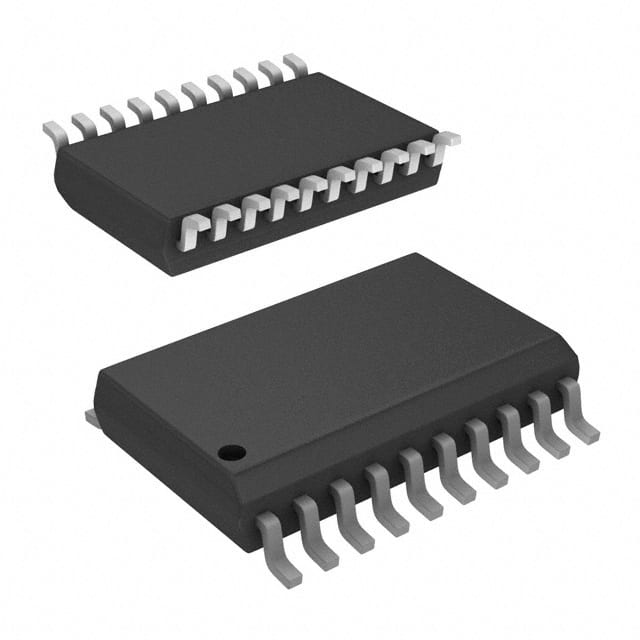PIC16LF1509-E/SO
Product Overview
- Category: Microcontroller
- Use: Embedded systems, control applications
- Characteristics: Low power consumption, high performance, small form factor
- Package: SOIC (Small Outline Integrated Circuit)
- Essence: A microcontroller designed for low-power applications with advanced control capabilities
- Packaging/Quantity: Available in tape and reel packaging, quantity depends on the supplier
Specifications
- Architecture: 8-bit
- CPU Speed: Up to 20 MHz
- Program Memory Size: 14 KB
- RAM Size: 512 bytes
- Number of I/O Pins: 18
- ADC Channels: 12
- Communication Interfaces: SPI, I2C, UART
- Operating Voltage Range: 1.8V to 5.5V
- Temperature Range: -40°C to +125°C
Pin Configuration
The PIC16LF1509-E/SO microcontroller has a total of 18 pins. The pin configuration is as follows:
```
| | | 1 18 | |_______| ```
Functional Features
- Low power consumption: The microcontroller is designed to operate efficiently in low-power applications, making it suitable for battery-powered devices.
- High performance: With a CPU speed of up to 20 MHz, the PIC16LF1509-E/SO offers fast processing capabilities for control applications.
- Small form factor: The SOIC package allows for compact designs, making it ideal for space-constrained applications.
- Advanced control capabilities: The microcontroller includes features such as PWM (Pulse Width Modulation) and timers, enabling precise control of connected devices.
Advantages and Disadvantages
Advantages: - Low power consumption extends battery life in portable devices. - High-performance CPU enables fast execution of control algorithms. - Small form factor allows for compact and space-efficient designs. - Advanced control capabilities provide flexibility in various applications.
Disadvantages: - Limited program memory size may restrict the complexity of applications. - Limited RAM size may limit the amount of data that can be processed simultaneously. - The number of I/O pins may be insufficient for complex projects requiring numerous connections.
Working Principles
The PIC16LF1509-E/SO microcontroller operates based on an 8-bit architecture. It executes instructions stored in its program memory, interacts with external devices through its I/O pins, and utilizes its internal peripherals to perform various tasks. The microcontroller can communicate with other devices using SPI, I2C, or UART interfaces. Its low power consumption is achieved through efficient power management techniques, allowing it to operate for extended periods on limited power sources.
Detailed Application Field Plans
The PIC16LF1509-E/SO microcontroller finds applications in various fields, including but not limited to:
- Home automation: Controlling lighting systems, temperature regulation, and security systems.
- Industrial automation: Monitoring and controlling machinery, process automation, and data acquisition.
- Automotive electronics: Engine control units, dashboard displays, and vehicle diagnostics.
- Consumer electronics: Remote controls, smart appliances, and wearable devices.
- Medical devices: Patient monitoring systems, drug delivery systems, and diagnostic equipment.
Detailed and Complete Alternative Models
- PIC16LF1508-E/SO: Similar to PIC16LF1509-E/SO but with a lower number of I/O pins (14 instead of 18).
- PIC16LF1506-E/SO: Similar to PIC16LF1509-E/SO but with a smaller program memory size (7 KB instead of 14 KB).
- PIC16LF1504-E/SO: Similar to PIC16LF1509-E/SO but with a lower number of ADC channels (8 instead of 12).
These alternative models offer different specifications and may be suitable for specific application requirements.
Word count: 452 words
قم بإدراج 10 أسئلة وإجابات شائعة تتعلق بتطبيق PIC16LF1509-E/SO في الحلول التقنية
What is the maximum operating frequency of PIC16LF1509-E/SO?
- The maximum operating frequency of PIC16LF1509-E/SO is 32 MHz.Can PIC16LF1509-E/SO be used in battery-powered applications?
- Yes, PIC16LF1509-E/SO is suitable for battery-powered applications due to its low power consumption.What are the available communication interfaces on PIC16LF1509-E/SO?
- PIC16LF1509-E/SO features SPI, I2C, and UART communication interfaces.Is PIC16LF1509-E/SO compatible with common development tools?
- Yes, PIC16LF1509-E/SO is compatible with popular development tools such as MPLAB X IDE and PICkit 3.What are the key peripherals integrated into PIC16LF1509-E/SO?
- PIC16LF1509-E/SO includes analog-to-digital converters (ADC), timers, and comparators.Can PIC16LF1509-E/SO operate in harsh environments?
- Yes, PIC16LF1509-E/SO is designed to operate in harsh environments with its wide temperature range and robust design.What programming languages are supported for PIC16LF1509-E/SO?
- PIC16LF1509-E/SO supports programming in C, assembly, and other high-level languages compatible with Microchip's compilers.Does PIC16LF1509-E/SO have built-in security features?
- Yes, PIC16LF1509-E/SO offers security features such as code protection and data EEPROM/Flash memory.Can PIC16LF1509-E/SO be used in automotive applications?
- Yes, PIC16LF1509-E/SO is suitable for automotive applications with its AEC-Q100 qualification and robustness.What are the available package options for PIC16LF1509-E/SO?
- PIC16LF1509-E/SO is available in various package options including SOIC, DIP, and QFN.


